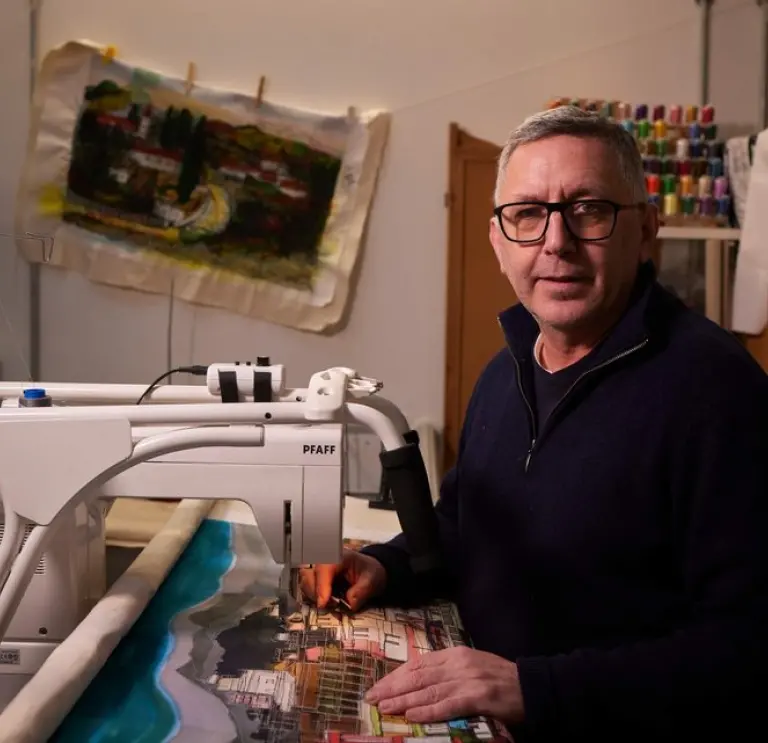A Welsh artist is hoping his latest work will shine a light on a community in India, which has a strong, but little-known, connection to Wales.
The Khasi people, who live in the north-east of the country, have a long history with Wales, after Welsh missionaries arrived in the 1840s. They aided with the establishment of hospitals and schools and even helped preserve their language.
Prior to the arrival of these Welsh missionaries, the language of the Khasi was primarily oral. Being put into script, with help from the likes of missionary Rev Thomas Jones, has helped keep the language alive today. There’s even an annual holiday named after Jones.
Now, Welsh textiles artist Cefyn Burgess wants to shine a light on the Khasi culture – especially because of that strong connection with Wales.
Back when Cefyn, 63, was a child, his weekly visits to his Sunday school in Bethesda saw him become familiar with the links to India, thanks to fundraising efforts in the form of collection boxes.
His latest exhibition, Behind the Box, is a journey to get to know the people and places behind those collection boxes he remembers from his childhood Sunday school.
Following a research trip to northeast India – more specifically Khasi, Jainita Hills and Mizoram – Cefyn was able to create something special, that he describes as a “narrative” piece of work.
While some parts of the culture were familiar to him, he’s been learning Khasi history from scratch.
He said: “It's like learning to read and learning to read this story for the first time. I’m taking myself and others on a journey. There’s a narrative, rather than one piece of work.”
Discussing the people he’s met along the way, Cefyn said: “They get under your skin, and you’ll fall in love with them. They are amazing people to get to know.
“I’m very privileged and grateful to be able to put the light on them, to try to show Wales, to say look at the story and the people we are associated with.”
The thinking behind the work is, in Cefyn’s words: “To get the know the people Behind the Box – because as a child I didn’t know who that money was for – it said India. But it ended up in a part of India that’s not ‘Indian’ as such, they’re Khasis.”
2024 is the year of Wales in India, which celebrates and strengthens the deep-rooted economic, educational, artistic and sporting ties between two nations. And of course, Cefyn’s work is playing a big role in linking the two countries, culturally and historically through his art.
He said: “In northeast India, you come across the Welsh footprint. Architecturally no, because the old chapels and things have gone. They’re building giant ones because they've got a revival going on. They’re building new concrete ones; massive presbyterian churches.”
The links between the two cultures aren’t going away anytime soon, either. Mair Jones, renowned international harpist and friend of Cefyn, sadly passed away in 2021. But she also created a Welsh connection of her own with the Khasis, just as Cefyn has.
Cefyn said: “She had started to record a lot of things from the Khasi hymn book onto the harp to take back to Shillong, to mark the centenary of the Gordon Roberts [Welsh mission] hospital.”
Since then, a scholarship has been set up in her name and Mair’s harp went to a university in the Khasi region of Shillong.
Cefyn also explained that the Meghalaya state, where the Khasi predominately live, has an annual holiday – Thomas Jones Day – because: “his efforts to put the Khasi language down in a written form, using Welsh and the Welsh alphabet as the blueprint is the reason they’ve got it”.
He said: “They're well aware of Thomas Jones and what the Welsh have done, in setting up the schools and education.”
“The Welsh actually learnt Khasi,” Cefyn added. “They integrated; they learnt Khasi before they went out there. So, they would do the sermon in the chapels in Khasi.
“They’re well aware of who the Welsh are, more than anyone else really.”
Behind the Box is part of an ongoing cultural research project in north-east India, supported by Wales Arts International.
Cefyn’s exhibition is open now and running until September 21, 2024, at the Mission Gallery in Swansea.
For more information on the exhibition, go to missiongallery.co.uk/exhibitions/tu-l-ir-blwch-behind-the-box2/
Also, part of the work, including new work on Khasi Monoliths, are to be seen in the exhibition in the Royal Cambrian Academy Gallery at Conwy.
